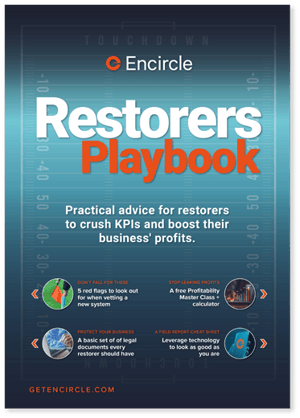Facing the talent crunch head-on: A restoration industry insight
83% of leaders struggle with recruiting and retaining top talent, as highlighted by CleanFax’s 2023 Restoration Benchmarking Survey Report. The demand for skilled professionals in areas like water damage and mold remediation is at an all-time high.
Today's workforce is looking for more than just a paycheck; they want roles offering work/life balance and a sense of purpose. Luckily, you're not alone in this challenge.
With the help of a few industry veterans, we've put together some practical strategies to help restoration businesses excel in attracting and retaining skilled workers.
MEET OUR RESTORATION EXPERT SPEAKERS

JACKIE CARPENTER
Chief Executive Officer, Ideal Inc.

PHILIP ROSEBROOK
President, Business Mentors, CR

MIKE MCCABE
Profit Detective, Business Development Associates Inc.
1. Turn recruitment into a business development strategy

In the competitive landscape of the restoration industry, adopting a business development mindset for recruitment can set you apart.
“If you like somebody, get them an offer letter that day. Speed works well. Even if we can’t fully vet them, we put an offer letter out, pending compliance checks.”
Jackie Carpenter, Owner and CEO of San Francisco's Ideal Restoration INC.
How to land top restoration talent, fast:
- Treat potential hires as valued clients: Create job descriptions that highlight your company's culture and the unique opportunities your team members have — sell the position.
- Use job search platforms and social media: Platforms like LinkedIn, Indeed, and Instagram aren't just for networking or marketing your services; they're powerful tools for showcasing your company culture and attracting like-minded candidates.
- Implement a fast-track hiring process: Show respect for candidates' time and decisiveness. Stand out from competitors by closing the deal quickly — a swift offer letter process can be the deciding factor for top talent considering multiple offers.
2. Look for good character and customer service experience
Valuing character and customer service experience is crucial for building a strong company culture. Phillip Rosebrook, CR, President of Business Mentors, emphasizes looking beyond the resume:

“When you’re in a tight labor market, the people you want are not answering ads, they’re busy working. You’re gonna have to find them, you’re gonna have to be creative. It has to be a function of your business.”
Another tip from Phillip: “Start handing out business cards to anybody you come across that’s hustling at their job. Because it’s a free interview.”
Actionable strategies for attracting and retaining skilled restorers:
- Champion character and customer service: Dive deeper than the resume to identify candidates who can contribute to a positive company culture and customer satisfaction.
- Leverage your network: Encourage your team to be on the lookout for potential hires in their daily interactions, embodying the principle that recruitment is a team sport.
- Create a community-driven referral program: Implement a program that rewards not just your employees but also customers for referring potential candidates. This turns your recruitment process into a collective effort.
3. Invest in employee development as a marketing tool
Investing in your team's growth not only enhances their skills but also fosters loyalty and turns them into advocates for your brand. Embracing innovative employee retention programs through comprehensive training and development, Jackie illustrates a holistic approach to employee investment:
“We need to be paying our blue-collar workers more... Aside from wages, there are other ways to invest in your employees. For example, our company helps our employees pay for their education—even if it’s not related to restoration.”
Action steps: cultivating growth and loyalty
- Promote your investment in growth: Commit to employee development, as a cornerstone of your employer brand. This strategy not only attracts talent but also keeps it by showing your dedication to their career and personal growth.
- Diversify training opportunities: To keep skilled workers, provide a range of training and development options from restoration-specific skills to broader education opportunities.
- Showcase growth paths: Use job postings and social media to highlight how employees can grow with your company. Be transparent about career paths in the restoration industry — this not only attracts candidates interested in long-term growth, but also reinforces your commitment to their development.
4. External perspective for internal branding
A fresh perspective can reveal insights into creating competitive benefits packages for SMEs and crafting an employee value proposition that sets restoration companies apart.
Mike McCabe, with years of experience at Paul Davis and mentoring at numerous locations, advises:

“I encourage management to develop their employee brand alongside their marketing one. Dedicate time to marketing to potential employees as you would for new customers.”
Action Steps:
- Do regular brand audits: Take a step back to view your company as an outsider would. This can help you identify areas where your employer brand can be strengthened to attract and retain top talent.
- Showcase your team's impact: Make sure your communication platforms highlight how your employees make a difference in people's lives. This not only celebrates their achievements but also showcases your company's values and mission.
- Celebrate and communicate: Use your social media, website, and internal communications to regularly celebrate your team's achievements. This reinforces the value of their work and the positive culture of your company, aligning with strategies for leveraging social media for recruitment in restoration.
5. Cultivate a winning culture with marketing principles
Just as flexibility and understanding your customer's needs are pivotal in restoration marketing, they're equally important in creating a supportive work environment.
Retention strategies for high-turnover industries:
- Introduce flexible scheduling: Implement flexible work options to help employees balance their professional and personal lives, showing you value their well-being and boosting morale.
- Celebrate team successes: Regularly recognize and celebrate achievements within the company to foster a positive culture and encourage team unity.
- Regular pulse checks: Do routine surveys or feedback sessions to gather insights from your team on how to improve the work environment and address any concerns proactively.
- Clarify company values: Make sure everyone is aligned with the company's mission and values, reinforcing a sense of purpose and direction across the team.
Wrapping up
Talent management requires blending sales, marketing, and HR strategies to create a workplace that values growth and motivation. These strategies are just the beginning of building a team aligned with your mission.
Talent meets sales strategy
Discover how to apply these principles to your sales team with Nathan Cisney of Restoration Made Simple. Join us for the “Do Sales People Suck?” webinar that explores leveraging sales and marketing strategies for team growth and retention.
The Restorer’s Playbook
Explore insights and strategies from 14 restoration experts on navigating industry challenges such as program work, technical training, and technological advancements.

 By: The Encircle Team
By: The Encircle Team